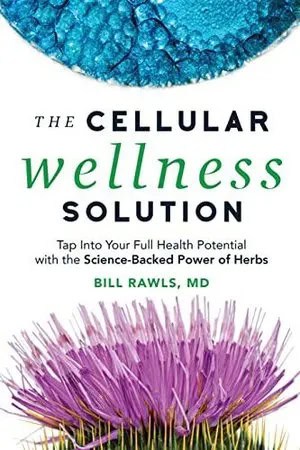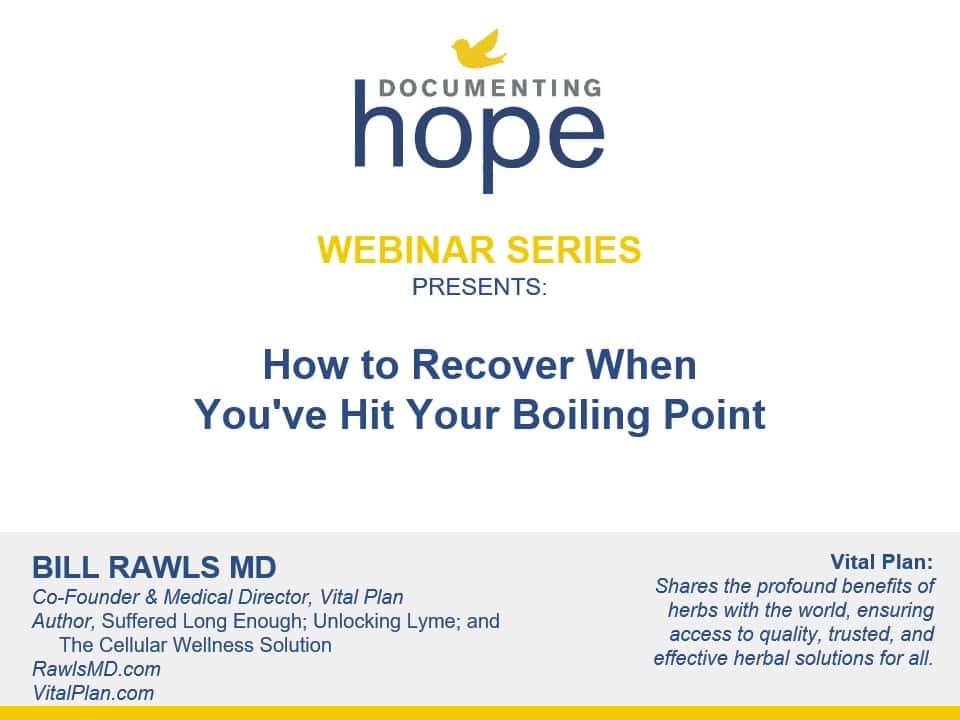Understanding Dr. Rawls’ Five Categories of Cellular Stress Factors
Dr. Rawls believes that all chronic illnesses are linked to five categories of cellular stress factors. His core message is that while inflammation, hormone imbalances, or mitochondrial dysfunction are often blamed for chronic illnesses, these issues are themselves the result of deeper exposures to the five primary stress factors. Only by addressing nutritional, mental, toxic, physical, and microbial stressors can we restore true wellness at the cellular level—transforming chronic illness from an inescapable fate to a solvable puzzle. Ultimately, prioritizing the health of our cells through herbal medicine, dietary changes and lifestyle changes offers the most promising path to healing.
Nutritional Stress
Nutritional stress stems from diets that fail to provide the nutrients our cells require to function and repair themselves. Dr. Rawls points out that most modern diets are saturated with processed foods high in refined carbohydrates and low in plants and lean meats that humans evolved to consume. Starving our cells of critical vitamins, minerals, and other cofactors leads to dysfunction, triggering a cascade of cellular stress.
Mental Stress
Chronic mental and emotional stress, such as anxiety and constant “fight or flight” responses, places a heavy burden on our cellular biology. This stress keeps the body’s cells on high alert, undermining their capacity to rest, recover, and restore themselves—especially during sleep, a time when much of our cellular repair takes place.
Toxic Stress
Toxic stress involves the multitude of chemical exposures—ranging from industrial pollutants to everyday household chemicals—that accumulate in our bodies. These toxins literally clog up our cells, impairing their machinery much like sand thrown into an engine. Over time, this toxic overload accelerates cellular wear-and-tear and undermines our natural regenerative processes.
Physical Stress
Adequate exercise and proper sleep are essential for moving blood, flushing out cellular waste, and delivering nutrients while giving cells the downtime they need to heal. Dr. Rawls maintains that both excessive inactivity (as seen in sedentary lifestyles) and lack of sleep prevent our cells from recovering from daily stresses, leaving us in a chronic deficit and in cellular stress.
Microbial Stress
Finally, microbial stress arises from the presence of infectious organisms—bacteria, viruses, and fungi—that take up residence in our bodies. While the immune system can usually keep these in check, when our cells are already compromised by the other stress factors, microbes can reactivate, causing persistent, low-level infections that keep the body in a cycle of inflammation and disease.
“As long as you and your cells stay healthy, you’ll never even know (pathogenic microbes) are there.”
Embracing Herbs
In this book, Dr. Rawls teaches how to incorporate herbs safely into one’s daily life to improve cellular wellness. Some herbs are safer than others, and it’s important to know the difference. Drinking teas and cooking with kitchen herbs and spices is an easy way to do this, and he also instructs on how to use herbal supplements. Some of his favorite herbs, for different reasons, are (Obviously, one wouldn’t take all of these but would so based on a particular herb’s properties. We recommend finding a knowledgeable practitioner to help guide you):
- Rhodiola
- Reishi mushrooms
- Turmeric
- Gotu kola
- Shilajit (technically not a plant)
- Milk thistle
- Japanese knotweed
- Andrographis
- Cat’s claw
- Chinese skullcap
- Garlic
Staying Well and Living Well
This section of the book details many of the basics that we recommend for lowering the total load of stressors, such as:
- Eating a clean diet
- Cutting out sugar and processed carbohydrates
- Eliminating foods to which your child is sensitive or intolerant
- Eating fermented foods
- Greening your home and life
- Reducing stress and staying calm
- Moving the body every day
- Supporting the immune system (with herbs, of course!)
Solving Specific Health Problems
Some of the chronic health conditions detailed in this part of the book probably don’t pertain to children, but the ones that do are:
- Blood-sugar control
- Brain and nervous system health
- Gastrointestinal health
In Conclusion
The Cellular Wellness Solution offers a root-cause look at why chronic health conditions happen and how to heal from them using Dr. Rawls’ five cellular stressors framework and herbal medicine, diet and lifestyle changes to facilitate the healing. This book provides a well-rounded and empowering way to create health for people of all ages.
About Bill Rawls MD
Bill Rawls MD graduated from Bowman Gray School of Medicine at Wake Forest University in 1985. He holds his medical license in North Carolina.
Dr. Rawls has written extensively on health topics, including Lyme disease, fibromyalgia, and Chronic Immune Dysfunction. He’s the author of Suffered Long Enough; Unlocking Lyme; and The Celullar Wellness Solution. He has contributed to various health sites.
Aside from his writing, Dr. Rawls serves as Medical Director for Vital Plan, an herbal supplement and wellness company he co-founded with his daughter, Braden. You can find out more about him and his work at his websites https://rawlsmd.com and https://vitalplan.com

Still Looking for Answers?
Visit the Documenting Hope Practitioner Directory to find a practitioner near you.
Join us inside our online membership community for parents, Healing Together, where you’ll find even more healing resources, expert guidance, and a community to support you every step of your child’s healing journey.
Sources & References
Akhgarjand, C., et al. Does Ashwagandha supplementation have a beneficial effect on the management of anxiety and stress? A systematic review and meta-analysis of randomized controlled trials. Phytother Res. 2022 Nov;36(11):4115-4124.
Allen, R.W., et al. Cinnamon use in type 2 diabetes: an updated systematic review and meta-analysis. Ann Fam Med. 2013 Sep-Oct;11(5):452-9.
Ankri, S., et al. Antimicrobial properties of allicin from garlic. Microbes Infect. 1999 Feb;1(2):125-9.
Arado, G.M., et al. Anti-inflammatory and/or immunomodulatory activities of Uncaria tomentosa (cat's claw) extracts: A systematic review and meta-analysis of in vivo studies. Front Pharmacol. 2024 May 31:15:1378408.
Brorson, O., et al. Grapefruit seed extract is a powerful in vitro agent against motile and cystic forms of Borrelia burgdorferi sensu lato. Infection. 2007 Jun;35(3):206-8.
Feng, J., et al. Evaluation of Natural and Botanical Medicines for Activity Against Growing and Non-growing Forms of B. burgdorferi. Front. Med., 21 Feb 2020.
Feng, J., et al. Selective Essential Oils from Spice or Culinary Herbs Have High Activity against Stationary Phase and Biofilm Borrelia burgdorferi. Front Med (Lausanne).2017 Oct 11;4:169.
Gadidala, S.K., et al. Effect of garlic extract on markers of lipid metabolism and inflammation in coronary artery disease (CAD) patients: A systematic review and meta-analysis. Phytother Res. 2023 Jun;37(6):2242-2254.
Hawkins, J., et al. Black elderberry (Sambucus nigra) supplementation effectively treats upper respiratory symptoms: A meta-analysis of randomized, controlled clinical trials. Complement Ther Med. 2019 Feb:42:361-365.
He, Y., et al. Curcumin, inflammation, and chronic diseases: how are they linked? Molecules. 2015 May 20;20(5):9183-213.
Kim, S.K., et al. Hypoglycemic efficacy and safety of Momordica charantia (bitter melon) in patients with type 2 diabetes mellitus. Complement Ther Med. 2020 Aug:52:102524.
Kongkeaw, C., et al. Meta-analysis of randomized controlled trials on cognitive effects of Bacopa monnieri extract. J Ethnopharmacol. 2014;151(1):528-35.
Li, C., et al. The potential of plant extracts in cell therapy. Stem Cell Res Ther. 2022 Sep 14;13(1):472.
Li, Y., et al. The potential of dandelion in the fight against gastrointestinal diseases: A review. J Ethnopharmacol. 2022 Jul 15:293:115272.
Li, Z., et al. Ginger for treating nausea and vomiting: an overview of systematic reviews and meta-analyses. Int J Food Sci Nutr. 2024 Mar;75(2):122-133.
Liu, Q., et al. Antibacterial and Antifungal Activities of Spices. Int J Mol Sci. 2017 Jun 16;18(6):1283.
Siddiqui, M.Z. Boswellia serrata, a potential antiinflammatory agent: an overview. Indian J Pharm Sci. 2011 May;73(3):255-61.
Theophilus, P.A., et al. Effectiveness of Stevia Rebaudiana Whole Leaf Extract Against the Various Morphological Forms of Borrelia Burgdorferi in Vitro. Eur J Microbiol Immunol (Bp). 2015 Nov 12;5(4):268-80.
Wang, S., et al. Positive Role of Chinese Herbal Medicine in Cancer Immune Regulation. Am J Chin Med. 2020;48(7):1577-1592.
Zhang, J., et al. [Study on Panax notoginseng mobilizing marrow stem cells efferens efficiency of acute myocardial infarction in rats]. Zhongguo Zhong Yao Za Zhi. 2009 Apr;34(7):893-5.
Zheng, H., et al. Total saponins of Panax notoginseng enhance VEGF and relative receptors signals and promote angiogenesis derived from rat bone marrow mesenchymal stem cells. J Ethnopharmacol. 2013 Jun 3;147(3):595-602.
Resources
Buhner, Stephen Harrod. Healing Lyme: Natural Healing of Lyme Borreliosis and the Coinfections Chlamydia and Spotted Fever Rickettsiosis. Raven Press, 2015.
Buhner, Stephen Harrod. Herbal Antibiotics, 2nd Edition: Natural Alternatives for Treating Drug-resistant Bacteria. Storey Publishing, 2012.
Buhner, Stephen Harrod. Herbal Antivirals: Natural Remedies for Emerging & Resistant Viral Infections. Storey Publishing, 2013.
Candee, Andrea, et al. Gentle Healing for Baby and Child: A Parent's Guide to Child-Friendly Herbs and Other Natural Remedies for Common Ailments and Injuries. Gallery Books, 2003.
Gladstar, Rosemary. Herbs for Children's Health: How to Make and Use Gentle Herbal Remedies for Soothing Common Ailments. Storey Publishing, 2015.
Gladstar, Rosemary. Herbs for Stress & Anxiety: How to Make and Use Herbal Remedies to Strengthen the Nervous System. Storey Publishing, 2014.
Hoffmann, David. The Complete Illustrated Holistic Herbal: A Safe and Practical Guide to Making and Using Herbal Remedies. Element Books Ltd., 1996.
McIntyre, Anne. The Herbal for Mother and Child. Thorsons, 2003.





